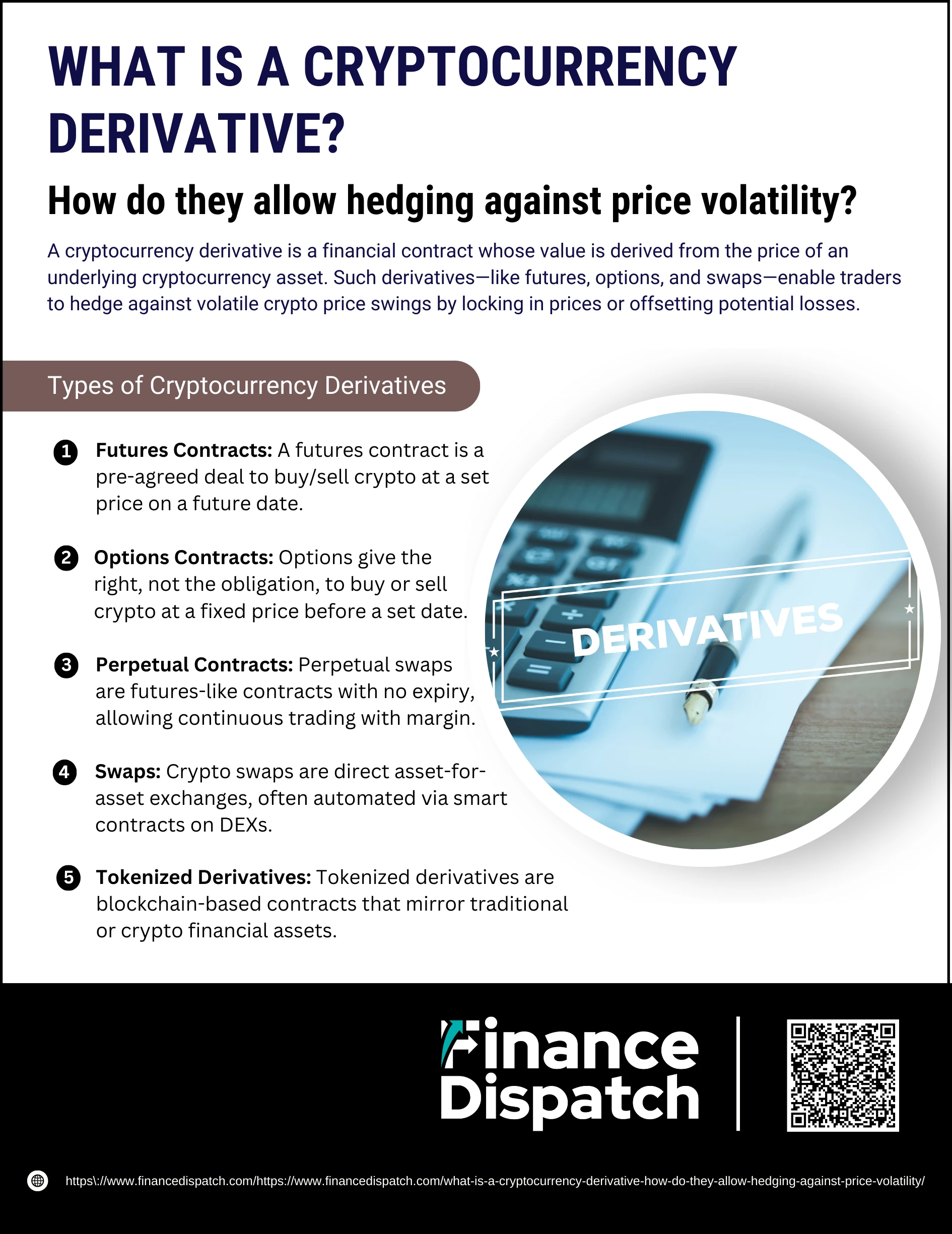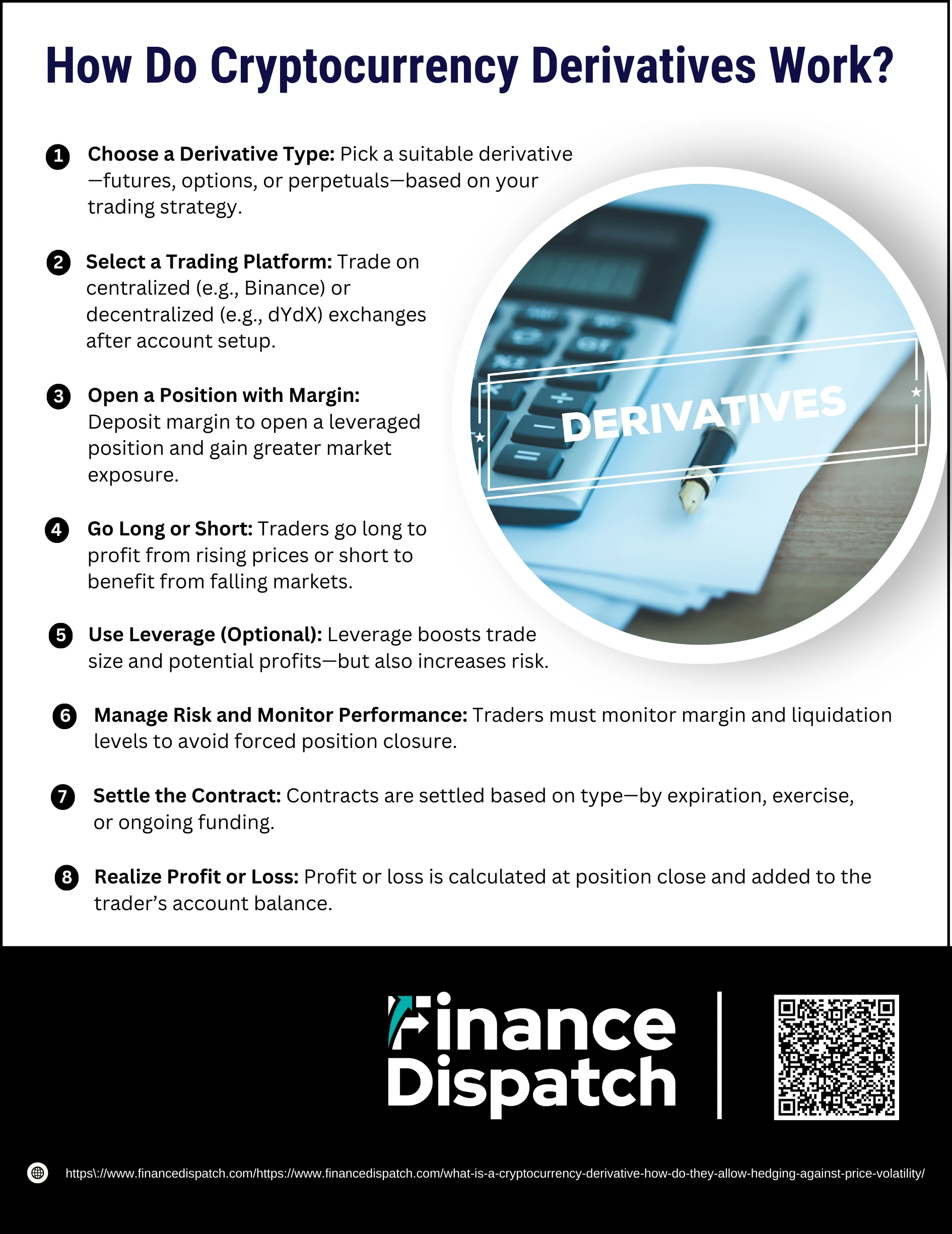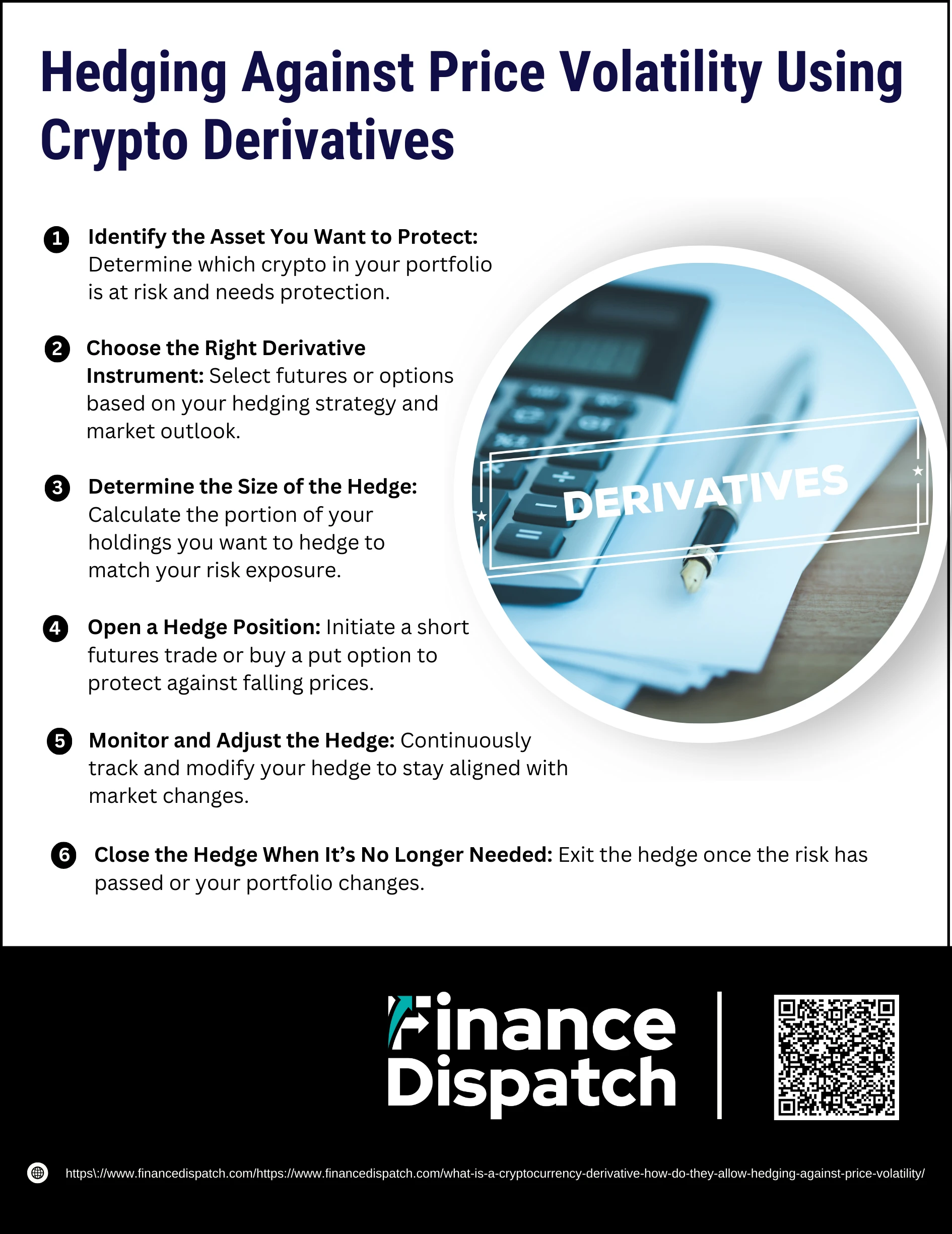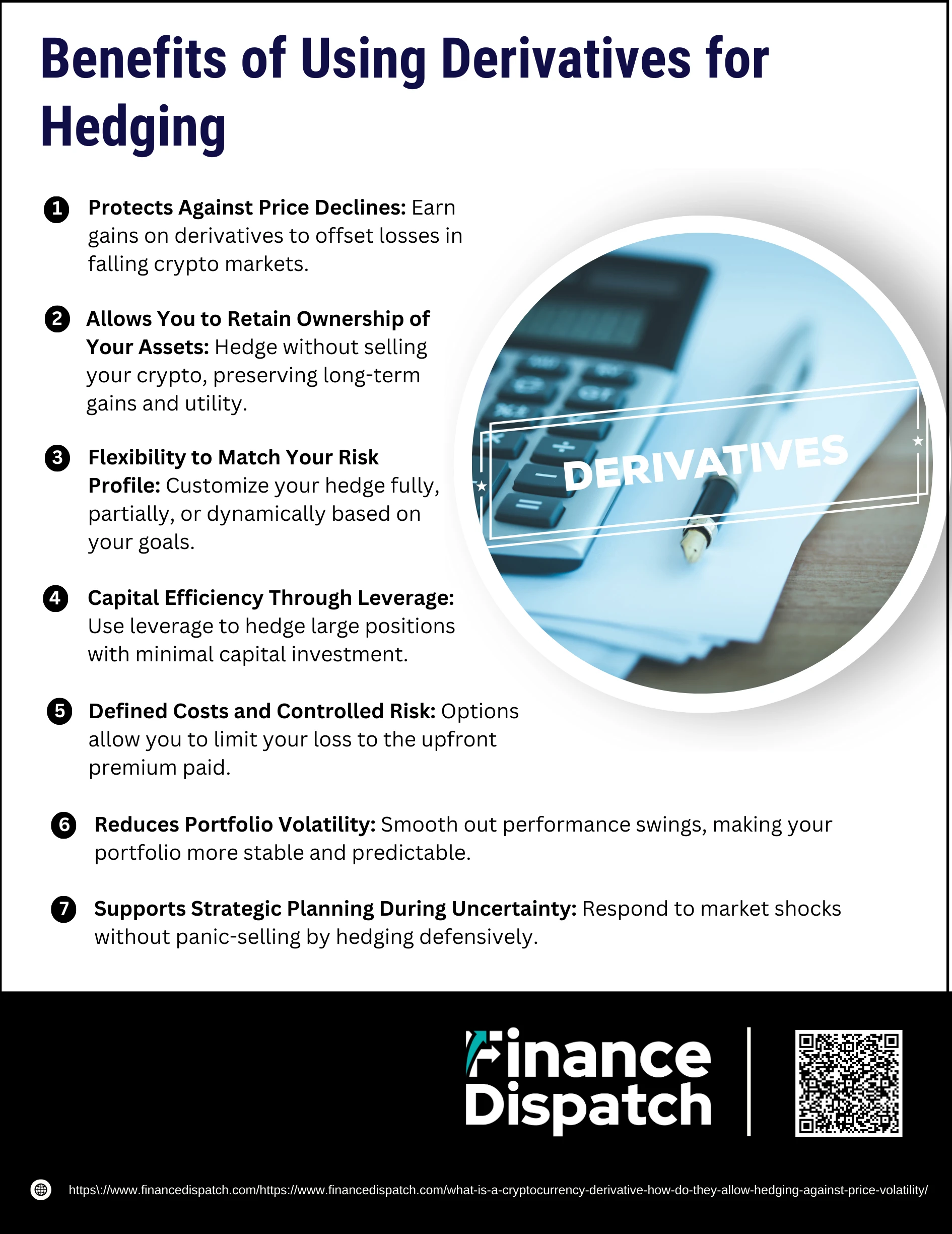In the fast-paced and often volatile world of cryptocurrencies, managing risk is just as important as seeking returns. That’s where cryptocurrency derivatives come into play. These are financial contracts whose value is based on the price of an underlying digital asset, such as Bitcoin or Ethereum. Rather than owning the cryptocurrency itself, traders use derivatives to speculate on price movements or to protect their portfolios from market swings. Among their many uses, one of the most strategic is hedging—taking calculated positions to offset potential losses. This article explores what cryptocurrency derivatives are, how they work, and how they serve as essential tools for hedging against unpredictable price fluctuations in the crypto market.
What is a Cryptocurrency Derivative?
A cryptocurrency derivative is a financial contract that derives its value from an underlying digital asset, such as Bitcoin, Ethereum, or other cryptocurrencies. Instead of directly buying or selling the cryptocurrency itself, traders enter agreements based on its future price. These contracts come in various forms—such as futures, options, swaps, and perpetual contracts—and are used to speculate on price movements, manage risk, or gain exposure to the crypto market without holding the asset. By separating ownership from price action, crypto derivatives offer flexibility for traders and investors looking to navigate the volatility of digital asset markets.
 Types of Cryptocurrency Derivatives
Types of Cryptocurrency Derivatives
Cryptocurrency derivatives come in several forms, each designed to meet different trading objectives such as speculation, hedging, or arbitrage. These financial instruments allow participants to engage with the crypto market in a more flexible and strategic manner—without the need to directly own the underlying digital asset. Below are the main types of crypto derivatives commonly used today:
1. Futures Contracts
A futures contract is an agreement between two parties to buy or sell a cryptocurrency at a predetermined price on a specific future date. These contracts are commonly used for speculation or hedging and are typically traded on regulated or crypto-specific exchanges. They allow traders to profit from both rising and falling markets using leverage.
2. Options Contracts
Options give traders the right, but not the obligation, to buy (call option) or sell (put option) a cryptocurrency at a fixed price before or on a certain date. This flexibility makes them popular for both risk management and speculative strategies. Traders pay a premium for this right, and if the market moves unfavorably, they can let the contract expire.
3. Perpetual Contracts
Perpetual swaps are similar to futures but have no expiration date. Traders can hold positions indefinitely, as long as margin requirements are met. A funding rate mechanism keeps the contract price aligned with the spot market price, and positions are typically adjusted every few hours.
4. Swaps
Crypto swaps involve exchanging one digital asset for another at a pre-agreed rate. These are often used for arbitrage, risk management, or to gain different market exposures. Swaps can be facilitated through decentralized exchanges (DEXs) using smart contracts.
5. Tokenized Derivatives
Tokenized derivatives are blockchain-based representations of traditional or crypto-based financial contracts. These are created using smart contracts and can represent anything from stocks and commodities to crypto indices. They are traded on DeFi platforms and offer high transparency, global access, and 24/7 availability.
 How Do Cryptocurrency Derivatives Work?
How Do Cryptocurrency Derivatives Work?
Cryptocurrency derivatives function through contracts between buyers and sellers who agree on the future price of a digital asset—like Bitcoin or Ethereum—without the need to actually hold the asset itself. These contracts are designed to mirror the price movements of the underlying cryptocurrency and are typically traded on both centralized exchanges (such as Binance or CME) and decentralized platforms (like dYdX or Synthetix). By using crypto derivatives, traders can speculate on price direction, hedge existing holdings, or use leverage to increase their potential returns. Below is a step-by-step look at how these instruments actually work in practice:
1. Choose a Derivative Type
Traders first decide what type of derivative to trade—futures, options, perpetual swaps, or others—based on their investment goals. For example, a trader expecting high volatility might choose options, while someone looking for continuous exposure without expiration might opt for perpetual contracts.
2. Select a Trading Platform
Crypto derivatives can be traded on major centralized exchanges like CME, Binance, or Kraken, or on decentralized exchanges (DEXs) that use smart contracts. Traders typically need to register, verify their accounts, and deposit funds—either in fiat or crypto.
3. Open a Position with Margin
Once funded, the trader opens a position (a contract) by depositing an initial margin—a small percentage of the total trade value. This acts as collateral and allows the trader to control a much larger position, thanks to leverage.
4. Go Long or Short
Depending on market outlook, the trader can:
- Go long – expecting the asset’s price to rise.
- Go short – expecting the price to fall.
5. Use Leverage (Optional)
Leverage allows traders to magnify their exposure. For instance, with 10x leverage, a trader can control $10,000 worth of crypto with just $1,000. While this increases profit potential, it also significantly heightens risk—particularly in volatile markets.
6. Manage Risk and Monitor Performance
Traders must keep an eye on their margin ratio and be aware of the liquidation price. If the market moves against them and the account balance falls below the required maintenance margin, the platform may liquidate the position to prevent further losses.
7. Settle the Contract
Depending on the derivative type:
- Futures are settled on a predetermined date.
- Options can be exercised before or at expiration (if profitable).
- Perpetuals can be held indefinitely, with funding fees exchanged periodically between long and short positions.
8. Realize Profit or Loss
When the position is closed, the trader’s profit or loss is calculated based on the difference between the entry price and the exit price, minus any fees or funding charges. These are immediately reflected in the account balance.
 Hedging Against Price Volatility Using Crypto Derivatives
Hedging Against Price Volatility Using Crypto Derivatives
Cryptocurrency markets are known for their extreme price swings, which can result in significant gains but also substantial losses. To manage this risk, traders and investors use a strategy called hedging. Hedging involves taking an offsetting position in a derivative to protect an existing investment from adverse price movements. By using crypto derivatives like futures or options, one can limit potential losses without needing to sell their original holdings. Here’s how hedging with cryptocurrency derivatives works in practice:
1. Identify the Asset You Want to Protect
Start by determining which cryptocurrency in your portfolio is exposed to volatility. For example, if you hold Bitcoin and fear a potential price drop, you can hedge this position using derivatives.
2. Choose the Right Derivative Instrument
Select a suitable derivative based on your strategy:
Futures contracts allow you to take a short position to profit from a price decline.
Options contracts let you buy a “put option” to sell the asset at a fixed price, offering downside protection with limited risk.
3. Determine the Size of the Hedge
Calculate how much of your portfolio you want to hedge. If you want to fully protect your Bitcoin holdings, your derivative position should closely match the size of your current exposure.
4. Open a Hedge Position
On a derivatives trading platform, open a short position (for futures) or buy a put option (for options). This position will increase in value if the asset’s price falls, helping offset losses in your actual crypto holdings.
5. Monitor and Adjust the Hedge
Crypto markets move quickly. It’s important to actively monitor your hedge and adjust the size or type of the position if market conditions change or if your exposure increases or decreases.
6. Close the Hedge When It’s No Longer Needed
Once the risk of price decline has passed or your portfolio changes, you can close the hedge to lock in any gains from the derivative and avoid unnecessary costs such as funding fees or premiums.
 Benefits of Using Derivatives for Hedging
Benefits of Using Derivatives for Hedging
In the world of cryptocurrency, volatility is both an opportunity and a threat. Prices can soar or plunge within minutes, making it difficult for investors to manage risk—especially if they hold large or long-term positions. Derivatives offer a practical and strategic solution through hedging, allowing traders and investors to reduce their exposure to adverse market movements without selling their underlying assets. Whether you’re a retail investor safeguarding your Bitcoin holdings or an institution managing a diversified crypto portfolio, derivatives can help create stability in an otherwise unpredictable market. Below are the most important benefits of using derivatives for hedging:
1. Protects Against Price Declines
Derivatives are especially effective when the market turns bearish. By opening a short futures position or purchasing a put option, traders can earn profits that offset losses from their spot holdings. For example, if you hold 10 ETH and anticipate a price drop, a short futures contract can help you preserve the value of your portfolio—even as the market falls.
2. Allows You to Retain Ownership of Your Assets
Selling your crypto holdings during market uncertainty might lock in losses or result in missed long-term gains. Derivatives allow you to hedge while still owning and controlling your original assets. This is particularly useful for long-term holders who believe in the future of the asset or those participating in staking, yield farming, or governance activities on blockchain networks.
3. Flexibility to Match Your Risk Profile
Crypto derivatives come in various forms—futures, options, perpetual swaps, and tokenized products—each offering a different level of risk and reward. This gives investors the flexibility to hedge exactly how they want. You can:
- Fully hedge by covering 100% of your exposure.
- Partially hedge by covering just a portion.
- Dynamically adjust positions based on market movement.
4. Capital Efficiency Through Leverage
With leverage, you can open a hedging position using only a small percentage of the trade’s full value. For instance, with 10x leverage, you can protect a $10,000 Bitcoin position using just $1,000 in margin. This frees up capital to be used elsewhere, allowing you to hedge efficiently while maintaining liquidity.
5. Defined Costs and Controlled Risk
When using options for hedging, your cost is limited to the premium you pay upfront. Even if the market doesn’t move in your favor, your maximum loss is known in advance. This allows you to structure a hedge with predictable risk, which is especially valuable in highly volatile markets where large, unexpected moves are common.
6. Reduces Portfolio Volatility
Hedging helps smooth out the ups and downs in your portfolio. This is crucial for institutional investors, crypto funds, or even long-term retail investors who are sensitive to performance swings. A less volatile portfolio is also more attractive to stakeholders, clients, and partners who value stability over speculative gains.
7. Supports Strategic Planning During Uncertainty
In times of market uncertainty—such as regulatory news, exchange hacks, or macroeconomic shocks—derivatives give you the ability to react quickly without panic-selling. You can maintain your core holdings while insulating them from short-term losses, giving you time to re-evaluate and respond to market developments strategically.
Risks and Challenges of Crypto Derivatives
While cryptocurrency derivatives offer powerful tools for hedging, speculation, and portfolio management, they also come with significant risks and challenges—especially for inexperienced traders. The use of leverage, rapid market movements, and evolving regulations make the derivatives space both complex and potentially dangerous. Understanding these risks is essential before entering the market, as improper use can lead to substantial financial loss. Below are the key risks and challenges associated with trading crypto derivatives:
1. High Leverage Risk
Crypto derivatives often allow extreme levels of leverage—sometimes up to 100x—which can amplify both profits and losses. Even a small price move in the wrong direction can result in liquidation and the total loss of your margin.
2. Extreme Market Volatility
The cryptocurrency market is notoriously volatile. Sudden price swings can trigger stop-losses, margin calls, or liquidations, especially in leveraged positions.
3. Lack of Regulation
Many crypto derivatives platforms operate in loosely regulated or unregulated environments. This increases the risk of fraud, poor consumer protection, and legal uncertainty—especially if the exchange is based overseas.
4. Counterparty Risk
On centralized platforms, there’s a risk that the exchange might become insolvent or misuse customer funds. In decentralized environments, smart contract bugs can expose traders to losses.
5. Complex Products and Strategies
Derivatives require a solid understanding of trading mechanics, margin requirements, and risk management. Many traders use them without fully understanding the implications, leading to poor decisions and significant losses.
6. Funding Rate Fluctuations
In perpetual contracts, funding fees are paid between long and short traders to keep prices in line with the spot market. These rates can fluctuate unpredictably, reducing profitability or even turning a winning trade into a loss.
7. Platform and Liquidity Risks
Smaller or newer exchanges may have low liquidity, causing slippage or order execution issues. Technical outages during high-volume periods can also prevent timely entry or exit from trades.
8. Regulatory Crackdowns
Governments around the world are still defining how crypto derivatives should be regulated. Sudden bans or restrictions can cause market disruptions and impact your ability to trade or withdraw funds.
9. Psychological Pressure
The fast-paced and high-stakes nature of derivatives trading can lead to emotional decision-making, overtrading, or panic—especially under pressure from margin calls or volatile swings.
Crypto Derivatives vs Traditional Derivatives
Cryptocurrency derivatives and traditional derivatives share a common foundation: both are financial contracts based on the value of an underlying asset. However, they differ significantly in terms of accessibility, regulation, market hours, underlying assets, and trading infrastructure. These differences reflect the unique characteristics of the crypto market compared to traditional finance. Understanding how the two compare helps investors decide which market better suits their trading strategies, risk tolerance, and investment goals. The table below outlines the key differences:
| Aspect | Crypto Derivatives | Traditional Derivatives |
| Underlying Assets | Cryptocurrencies (e.g., BTC, ETH, altcoins) | Stocks, commodities, interest rates, currencies |
| Market Hours | 24/7, including weekends and holidays | Limited to business hours (weekdays) |
| Regulation | Light or emerging regulation (varies by region) | Heavily regulated by financial authorities (e.g., SEC, CFTC) |
| Access | Global, open to retail and institutional users | Often restricted to accredited investors or licensed traders |
| Leverage | High leverage (up to 100x in some cases) | Moderate leverage (typically 2x–10x) |
| Settlement | Often settled in crypto or stablecoins | Settled in fiat currencies or physical delivery |
| Platform Type | Centralized & decentralized exchanges (CEXs & DEXs) | Traditional financial institutions and brokerages |
| Volatility | Highly volatile due to emerging nature of the market | Generally lower volatility |
| Technology | Blockchain-based, with smart contract integration in DeFi | Based on traditional financial infrastructure |
| Innovation Speed | Rapid innovation and new product development | Slower, due to regulatory and institutional constraints |
Who Uses Crypto Derivatives and Why?
Crypto derivatives are not just for professional traders—they serve a wide range of participants in the digital asset ecosystem. From retail investors seeking quick profits to institutional players managing multi-million-dollar portfolios, these financial instruments offer flexibility, strategic advantages, and access to advanced trading techniques. Each user group employs derivatives for different reasons, such as hedging, speculation, arbitrage, or risk management. Below is a breakdown of the key users of crypto derivatives and why they use them:
1. Retail Traders
Retail investors often use derivatives for speculative purposes, aiming to profit from short-term price movements with the help of leverage. Some also use them to hedge small portfolios or test out advanced strategies with minimal capital.
2. Institutional Investors
Hedge funds, asset managers, and family offices use crypto derivatives to manage risk, diversify portfolios, and gain exposure to crypto without holding the underlying asset. Their large volume trades also help improve market liquidity.
3. Miners
Cryptocurrency miners use derivatives—especially futures—to lock in the future value of the coins they mine. This allows them to stabilize revenues and protect against price drops that could impact profitability.
4. Market Makers and Liquidity Providers
These participants use derivatives to hedge positions, manage exposure, and provide liquidity to exchanges. Their activity ensures tighter spreads and better execution for all traders.
5. Arbitrage Traders
These traders exploit price differences between spot and derivatives markets or across exchanges. Derivatives allow them to implement complex arbitrage strategies like cash-and-carry or basis trading.
6. Long-term Holders (HODLers)
Even passive investors can use options or short futures to hedge their long-term holdings against temporary market dips without needing to sell the underlying asset.
7. Speculators and High-Frequency Traders (HFTs)
These traders rely on short-term strategies, technical indicators, and high-speed execution. Derivatives give them access to leverage and 24/7 markets, essential for their trading style.
Conclusion
Cryptocurrency derivatives have become essential tools in the digital asset market, offering traders and investors a way to manage risk, speculate on price movements, and gain strategic exposure without directly holding the underlying assets. While they provide significant advantages—such as hedging against volatility, capital efficiency, and portfolio flexibility—they also come with risks that require careful understanding and management. As the crypto market continues to mature, derivatives are likely to play an even larger role in shaping its structure and attracting institutional and retail participants alike. Whether used for hedging or high-level trading strategies, crypto derivatives represent a powerful component of modern financial innovation—one that blends opportunity with responsibility.



